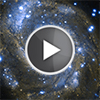CXC Home | Search | Help | Image Use Policy | Latest Images | Privacy | Accessibility | Glossary | Q&A
Tour of NGC 5195
Quicktime MPEG With closed-captions (at YouTube)
Astronomers using NASA's Chandra X-ray Observatory have discovered evidence for powerful blasts produced by a giant black hole. This is the nearest supermassive black hole to Earth that is currently undergoing such violent outbursts. The researchers found this behavior in the famous Messier 51 system of galaxies, which is located about 26 million light years from Earth. This system contains a large spiral galaxy, NGC 5194 (a.k.a. "The Whirlpool"), merging with a smaller companion galaxy, NGC 5195, where these outbursts are occurring.
A team of astronomers found a pair of arcs in the X-ray data, which they interpret to be the artifacts of two enormous blasts from the supermassive black hole at the center of NGC 5195 that happened millions of years ago. Scientists think that in the early Universe black holes would have had these kinds of outbursts quite often, impacting the evolution of galaxies they inhabited. What makes this new discovery from Chandra important is that the outbursts in NGC 5195 are so nearby, astronomically speaking. This allows astronomers to have a rare close-up look at this behavior. Astronomers will continue to study systems like NGC 5195 to better understand how black holes and galaxies affect one another.
[Runtime: 02:22]
Quicktime MPEG With closed-captions (at YouTube)
Astronomers using NASA's Chandra X-ray Observatory have discovered evidence for powerful blasts produced by a giant black hole. This is the nearest supermassive black hole to Earth that is currently undergoing such violent outbursts. The researchers found this behavior in the famous Messier 51 system of galaxies, which is located about 26 million light years from Earth. This system contains a large spiral galaxy, NGC 5194 (a.k.a. "The Whirlpool"), merging with a smaller companion galaxy, NGC 5195, where these outbursts are occurring.
A team of astronomers found a pair of arcs in the X-ray data, which they interpret to be the artifacts of two enormous blasts from the supermassive black hole at the center of NGC 5195 that happened millions of years ago. Scientists think that in the early Universe black holes would have had these kinds of outbursts quite often, impacting the evolution of galaxies they inhabited. What makes this new discovery from Chandra important is that the outbursts in NGC 5195 are so nearby, astronomically speaking. This allows astronomers to have a rare close-up look at this behavior. Astronomers will continue to study systems like NGC 5195 to better understand how black holes and galaxies affect one another.
[Runtime: 02:22]
(Credit: NASA/CXC/A. Hobart)
Return to NGC 5195 (January 5, 2016)



